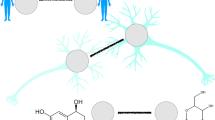Abstract
Biological processes such as the interaction between proteins or metabolic reactions can be represented by networks which can be modeled by graphs. Biological networks are present in the cell and outside the cell. Our aim in this chapter is to first introduce the networks in the cell and analyze them as graphs. Centrality analysis provides information about the important nodes and edges in biological networks and we describe algorithms to find various centrality measures. The main problems to investigate in the graph structure of a biological network are the module detection, discovery of recurrent subgraphs called network motifs and aligning two or more networks as we discuss. We will see these networks have interesting features such as small-world, scale-free properties which are not found in random networks. All of these problems are discussed in detail in the rest of this part of the book.
Access this chapter
Tax calculation will be finalised at checkout
Purchases are for personal use only
Similar content being viewed by others
References
Albert R, Othmer HG (2003) The topology of the regulatory interactions predicts the expression pattern of the drosophila segment polarity genes. J Theor Biol 223:1–18
Albert R, Barabasi A (2002) The statistical mechanics of complex networks. Rev Mod Phys 74:47–97
Bassett DS, Bullmore E, Verchinski BA et al (2008) Hierarchical organization of human cortical networks in health and schizophrenia. J Neurosci 28:9239–9248
Pablo Carbonell P, Anne-Galle Planson A-G, Davide Fichera D, Jean-Loup Faulon J-P (2011) A retrosynthetic biology approach to metabolic pathway design for therapeutic production. BMC Syst Biol 5:122
Davidson EH, Rast JP, Oliveri P, Ransick A et al (2020) A genomic regulatory network for development. Science, 295:1669–1678
Eguiluz VM, Chialvo DR, Cecchi GA, Baliki M, Apkarian AV (2005) Scale-free brain functional networks. Phys Rev Lett 94:018102
Identifying gene regulatory networks from gene expression data
Floyd RW (1962) Algorithm 97: shortest path. Comm ACM 5(6):345
Goh K, Kahng B, Kim D (2005) Graph theoretic analysis of protein interaction networks of eukaryotes. Physica A 357:501–512
He Y, Chen Z, Evans A (2010) Graph theoretical modeling of brain connectivity. Curr Opin Neurol 23(4):341–350
He Y, Chen Z, Evans A (2008) Structural insights into aberrant topological patterns of large-scale cortical networks in Alzheimers disease. J Neurosci 28:4756–4766
Jeong H, Tombor B, Albert R, Oltvai ZN, Barabasi AL (2000) The large-scale organization of metabolic networks. Nature 407:651–654
Junker B (2008) Analysis of biological networks, Chap. 9. Wiley ISBN: 978-0-470-04144-4
Koschtzki D, Lehmann KA, Tenfelde-Podehl D, Zlotowski O (2005) Advanced centrality concepts. Springer-Verlag LNCS Tutorial 3418:83-111, In: Brandes U, Erlebach T (eds) Network analysis: methodological foundations
Mason O, Verwoerd M (2007) Graph theory and networks in biology. IET Syst Biol 1(2):89–119
Kaiser M, Martin R, Andras P, Young MP (2007) Simulation of robustness against lesions of cortical networks. Eur J Neurosci 25:3185–3192
Pavlopoulos GA, Secrier M, Moschopoulos CN, Soldatos TG, Kossida S, Aerts J, Schneider R, Bagos Pantelis GPG, (2011) Using graph theory to analyze biological networks. Biodata Mining 4:10. doi:10.1186/1756-0381-4-10
Perron O (1907) Zur Theorie der Matrices. Mathematische Annalen 64(2):248–263
Phizicky EM, Fields S (1995) Proteinprotein interactionsmethods for detection and analysis. Microbiol Rev 59:94–123
M. Ptashne (1992) A genetic switch: phage lambda and higher organisms, 2nd edn. Cell Press and Blackwell Scientific
Ravasz E, Somera AL, Mongru DA, Oltvai ZN, Barabsi AL (2002) Hierarchical organization of modularity in metabolic networks. Science 297:1551–1555
Rubinov M, Sporns O (2010) Complex network measures of brain connectivity: uses and interpretations. NeuroImage 52(3):1059–1069
Salvador R, Suckling J, Coleman MR, Pickard JD, Menon D, Bullmore E (2005) Neurophysiological architecture of functional magnetic resonance images of human brain. Cereb Cortex 15:1332–1342
Salwinski L, Eisenberg D (2003) Computational methods of analysis of proteinprotein interactions. Curr Opin Struct Biol 13:377–382
Schuster S, Fell DA, Dandekar T (2000) A general definition of metabolic pathways useful for systematic organization and analysis of complex metabolic networks. Nat Biotechnol 18:326–332
Seidenbecher T, Laxmi TTR, Stork O, Pape HC (2003) Amygdalar and hippocampal theta rhythm synchronization during memory retrieval. Science 301:846–850
Stumpf MPH, Wiuf C, May RM (2005) Subnets of scale-free networks are not scale-free: Sampling properties of networks. Proc National Acad Sci 102(12):4221–4224
Vidal M, Cusick ME, Barabasi AL (2011) Interactome networks and human disease. Cell 144(6):986–998
Vitale A (2002) Physical methos. Plant Mol Biol 50:825–836
Vogelstein B, Lane D, Levine A (2000) Surfing the p53 network. Nature 408:307–310
Watts DJ, Strogatz SH (1998) Collective dynamics of small-world networks. Nature 393:440–442
Author information
Authors and Affiliations
Corresponding author
Rights and permissions
Copyright information
© 2015 Springer International Publishing Switzerland
About this chapter
Cite this chapter
Erciyes, K. (2015). Analysis of Biological Networks. In: Distributed and Sequential Algorithms for Bioinformatics. Computational Biology, vol 23. Springer, Cham. https://doi.org/10.1007/978-3-319-24966-7_10
Download citation
DOI: https://doi.org/10.1007/978-3-319-24966-7_10
Published:
Publisher Name: Springer, Cham
Print ISBN: 978-3-319-24964-3
Online ISBN: 978-3-319-24966-7
eBook Packages: Computer ScienceComputer Science (R0)




